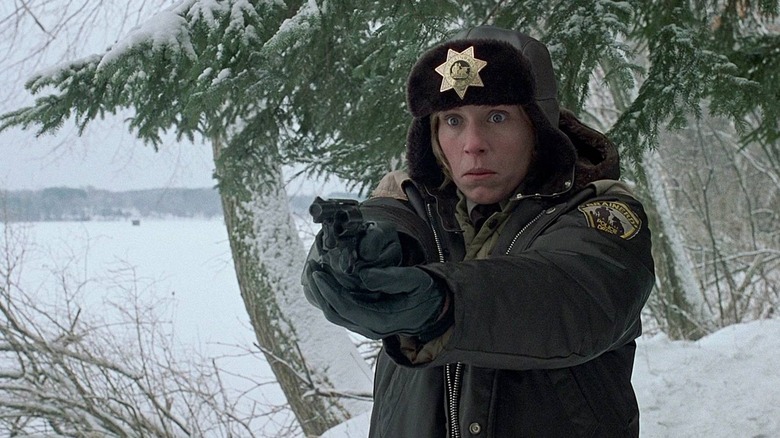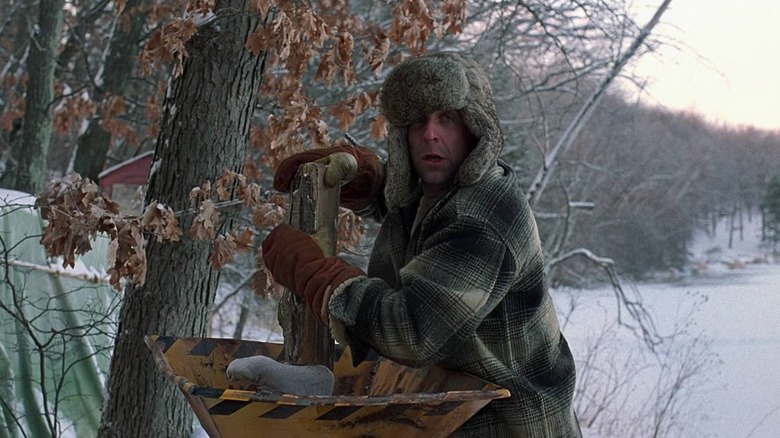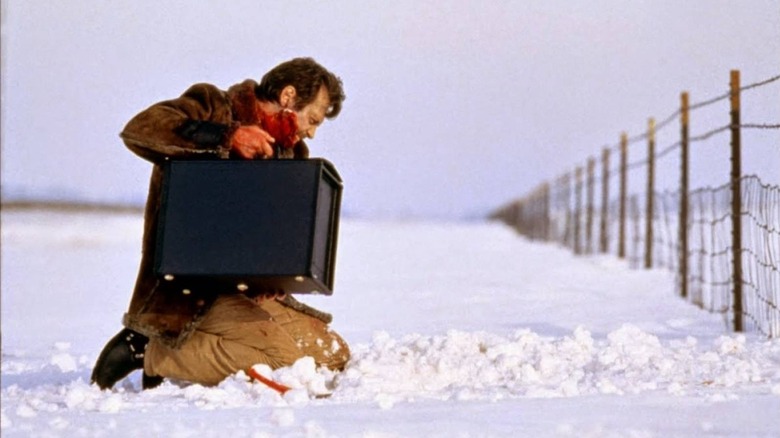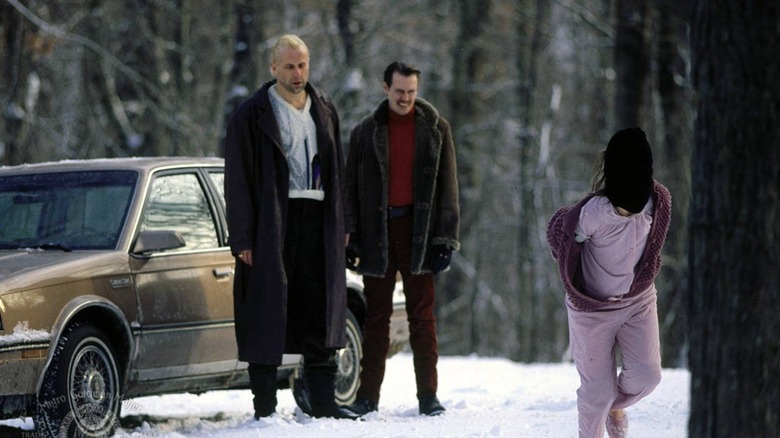Fargo Ending Explained: What Happened To The Money?
One of the greatest joys of "Fargo" is the way the Coen Brothers contrast the Minnesota Nice against the Minnesota Not-So-Nice. The grimy criminal underworld of 1980s Minnesota provides a stark contrast to the buffet-eating, darn-tooting Marge Gunderson (played by Frances McDormand) who happens to be leading the investigation when a state trooper and two passers-by are brutally killed outside Brainerd. Things go from bad to worse as the triple homicide ends up connected to the kidnapping of a local woman, and by the end of the movie, you're left wondering about the futility of it all.
Arresting Gaear (Peter Stormare) just moments after he was caught stuffing his partner Carl (Steve Buscemi) into a woodchipper, Chief Marge wraps it up perfectly:
"So, that was Mrs. Lundegaard on the floor in there. And I guess that was your accomplice in the woodchipper. And those three people in Brainerd. And for what? For a little bit of money? There's more to life than a little money, you know. Don'tcha know that? And here ya are, and it's a beautiful day. Well. I just don't understand it."
But let's back up a little bit. What led to the carnage that unfolds at the end of "Fargo?"
Let's recap what happened in Fargo
As you know, Carl and Gaear have been hired by Jerry Lundegaard (William H. Macy) to kidnap his wife in order to extort a princely ransom from his father-in-law, Wade (Harve Presnell). That all goes sideways when Wade shoots Carl during the handover. Of course, Carl guns him down in retaliation and makes off with a case full of cash — $1 million, to be exact, a lot more than he and his partner were expecting. Gaear and Carl were originally promised half of an $80,000 ransom.
With his partner at home keeping watch over the kidnapped Mrs. Lundegaard (Kristin Rudrüd) Carl hatches a cunning plan. Pulling over on the side of the road, he takes $80,000 cash from the case to split with Gaear and buries the rest in the snow, clearly intending to come back and collect it later. It's a cunning ploy by Carl to stiff his partner out of a cool $920,000.
But it doesn't exactly go to plan.
After arguing about who gets to keep their car (provided by Mr. Lundegaard in exchange for their services), Gaear brutally murders Carl with an axe and is caught by Chief Gunderson as he feeds his partner's body into a woodchipper. It's a hilariously grim conclusion to an already dark tale. But there's still one thread left hanging...
But what happened to the money?
After Carl's brutal execution at the hands of his partner, he was never able to retrieve his stash. That's right — he left almost $1 million buried in the snow at the side of a road in the middle of nowhere. Of course, that's not the end of the story.
Expanding upon the movie, "Fargo" got its own TV series in 2014, returning to Minnesota in the early 2000s with another bleak suburban tale of snow and slaughter. This time around, a highly-strung Lester Nygaard (played by Martin Freeman) murders his wife after years of nagging and a gentle push by the deliciously wicked Lorne Malvo (Billy Bob Thornton). But it's neither of these men who get their hands on the money.
Instead, it's supermarket magnate Stavros Milos (Oliver Platt) who gets his grubby hands on Carl's suitcase. Back in 1987, not long after the events of "Fargo," Stavros and his family are stranded at the side of the road after the family car runs out of gas. It's years before Stavros becomes the "Supermarket King" of Minnesota, and he's heavily in debt. Praying to God for a sign, he spots Carl's bright red ice pick at the side of the road. The rest is history.
Stavros digs up the money and eventually drives to Duluth with his family to start a new life. With a renewed faith in God, he uses the money to build his own supermarket empire. But his faith soon comes back to haunt him.
Years later, Stavros is being blackmailed by someone close to him and hires the tempestuous Lorne Malvo to help him find out who's responsible. Instead, Malvo takes over the blackmail scheme himself, recreating biblical plagues such as an infestation of locusts and a shower of blood to get him to crack. Terrified that he's being punished for taking the money all those years ago, Stavros stuffs a suitcase full of cash. But instead of paying his blackmailer, he buries it back at the side of the road where he once found it. But what does it all mean?
Fargo is a reminder that everything is futile
At the end of the day, Carl's money is just part of a circular narrative in "Fargo," which plays out across both the movie and TV show. Its lesson? Everything is futile. The pointlessness of it all is rammed home in Marge's final words to Gaear: "There's more to life than a little money, you know."
Gaear and Carl learned this the hard way, as did Jerry, who ends up arrested after his wife's kidnap and murder. There's more to life than a little money, but none of them realize that until it's far too late.
This grim futility finds its way into the TV show, too. Stavros repents and returns the money to whence it came. But even repenting isn't good enough. Malvo's fake biblical plagues put the fear of God into him, but it's a real act of God that puts the final nail in Stavros' coffin. Heading home empty-handed after burying his cash in the snow, he finds his best friend and son have been killed in a car accident — the result of freak weather conditions that caused fish to rain from the sky. After a life of misguided actions, even repenting couldn't save him from the wrath of God, an irony that speaks to the futility of it all.
Going back to the movie, the final scene shows Marge and her husband in bed — a typical small-town married couple, catching up at the end of their day. Norm (John Carroll Lynch) didn't win the prize he wanted in the postage stamp picture contest. But while snuggling in bed, Marge cheers him up, saying that folks use the three-cent stamp whenever postal charges go up. It's not the most exciting conversation, especially given everything that's gone down over the past few days. But as they express their love for each other and reflect on the future they'll soon have with their expected child, we're reminded of a harsh truth. The humdrum suburban home life of Marge and her husband represents a kind of happiness that's unattainable to Carl, Gaear, and Jerry. There's more to life than a little money, you know.



